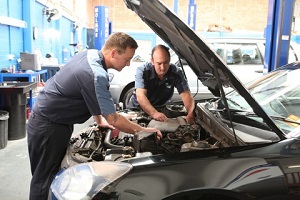Time has a way of sneaking up on everyone, and so does mileage on a vehicle. If you have a long commute or regularly put lengthy interstate trips on your car, you can easily rack up 15-18,000 miles a year. Even though today’s cars don’t need as much maintenance as cars from a generation ago, it’s still something you can’t neglect. Here’s a reminder of some important milestones for service on your vehicle:
Thank you for reading this post, don't forget to subscribe!Monthly
• Check tire inflation
• Check oil and transmission fluid levels
• Check all lights
• Check windshield washer fluid
Every 5,000 Miles
• Oil change (if using conventional motor oil), to prevent deposits from forming inside engine and accelerating wear on moving parts
• Tire rotation, to ensure even wear on all four tires by switching their positions on the vehicle
Every 15,000 Miles
• Replace air filter
• Replace cabin air filter
• Replace carbon canister filter (if applicable)
• Replace wiper blades
• Check battery for reserve starting power, check battery cables for good secure fit and clean corrosion and deposits from posts and battery clamps
• Check engine’s serpentine belt for signs of cracking, fraying, chunking or excessive wear
• Check all vacuum lines and hoses for wear and secure connections
Every 30,000 Miles
• Flush and replace transmission fluid, change transmission filter
• Flush old coolant from radiator, perform pressure test to check for leaks, replace coolant
• Run diagnostic check on engine – sometimes the engine’s computer can still register a trouble code without illuminating the Check Engine light.
• Lubricate door hinges, hood hinges and any other lubrication points on vehicle chassis and undercarriage
Every 60,000 Miles
• Repeat all above services from the 30,000 mile increment
• Replace engine timing belt, if applicable. Some manufacturers’ recommendations for timing belt replacement might vary from this interval; also, many vehicles are designed with a timing chain, which won’t need replacement for the life cycle of the vehicle.
• Check condition of brake pads and rotors
Every 100,000 Miles
• Replace spark plugs. This is something which used to be needed much more frequently, but today’s vehicles can easily go 100k miles on a set of spark plugs.
• Replace coil-on-plug coil packs if needed, and if applicable.
• Perform a compression check on all cylinders
• Check wheel bearings and CV joints on front-drive vehicles
These are all important service intervals to keep in mind in the life cycle of any vehicle. The good news is with this sort of scrupulous attention to maintenance, you can easily keep a vehicle on the road for 200-250,000 miles. It’s a pretty far cry from cars of the 1970’s and 80’s that would be ready for the salvage yard at 120,000 miles. If you’re approaching any of these milestones with your vehicle, give us a call and let us take care of your service and maintenance needs!


